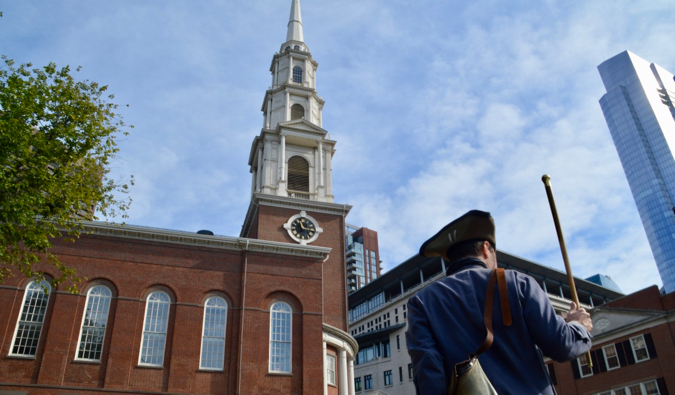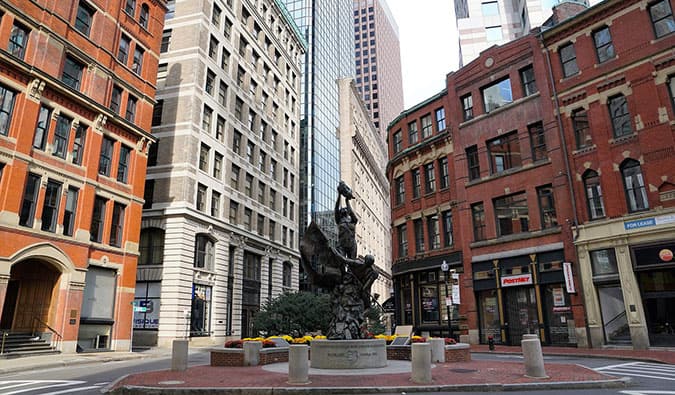
Posted: 5/30/2019 | May 20th, 2019
One of the most historic cities in the United States, Boston is the city I called home for the first 25 years of my life.
More a collection of towns than a metropolis like New York, Boston is a city steeped in history (it contains a lot of historical firsts for the United States and played a pivotal role in its founding), delicious food, wide-open green spaces, first-rate museums, and warm, welcoming people.
Visiting Boston offers all the benefits of a big metropolis without the intensity and fast pace of New York.
Boston is easy to get around and compact, making it perfect for travelers. The subway will take you wherever you need to go.
So how many days do you need to visit Boston?
Most people visit for three to four days, and I think that’s a perfect amount of time. As someone who’s lived there, I can say that, since Boston is so small, you won’t waste a lot of time “in transit,” so you can pack a lot into your days. Obviously, you can spend longer here (slow travel is the best travel), but for the first-time visitor, three to four days is enough.
Here’s a suggested Boston itinerary that will allow you to see the best of Boston:
Visiting Boston: Day 1
Take a Free Walking Tour
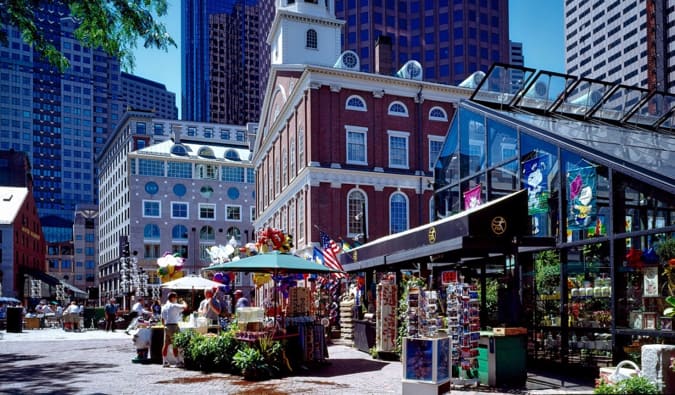
If walking the Freedom Trail and the Black Heritage Trail wasn’t enough for you, there are plenty of other walking/food tours around town to keep you entertained! While the food tours, wine tours (yes, there are wine tours!), and historical tours will cost money, both Free Tours by Foot and Strawberry Tours offer daily free walking tours around town. They’re a great way to get oriented and see the major sights without breaking the bank. Just be sure to tip your guides!
Hike the Freedom Trail
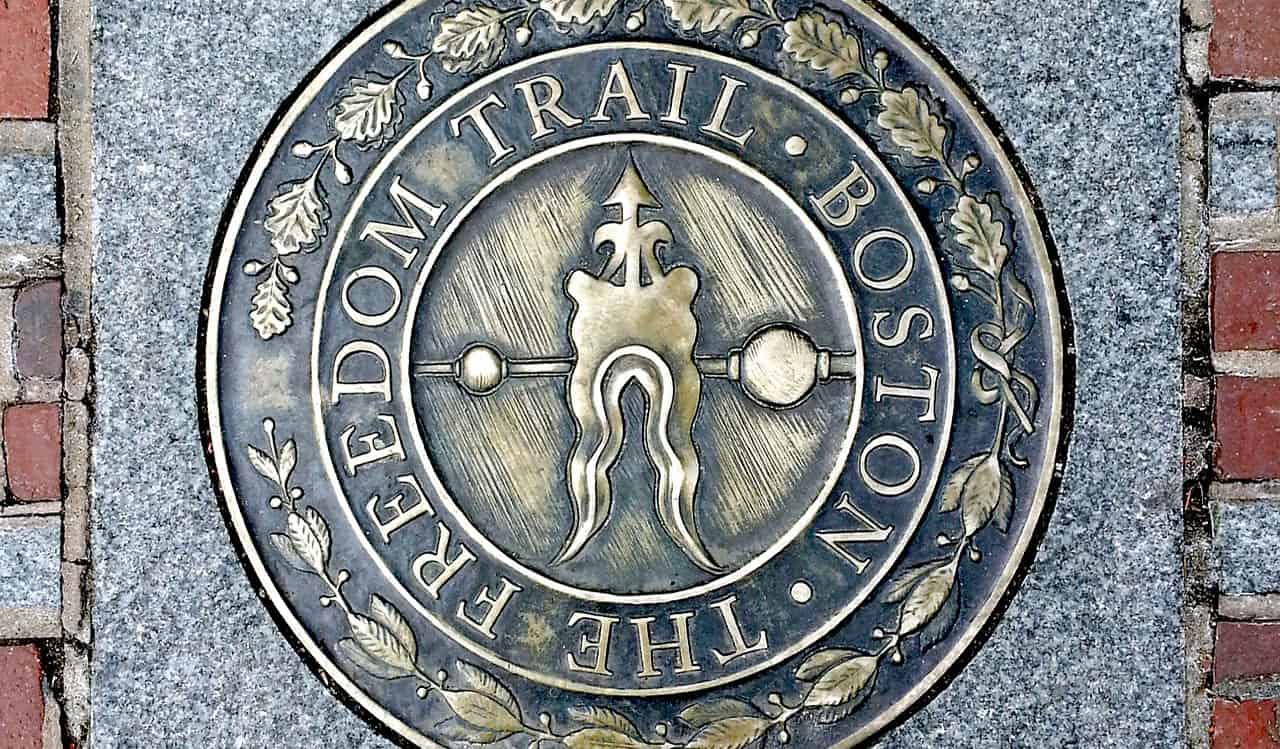
The Freedom Trail is a 2.5-mile walk through historic Boston. It takes you through all the major sites and monuments relating to the city’s founding and the Revolutionary War. The trail begins in the Boston Commons and ends at Bunker Hill. Along the way, you’ll see:
- Boston Commons
- Massachusetts State House
- Park Street Church
- Granary Burying Ground
- King’s Chapel Burying Ground
- Benjamin Franklin statue and the former site of Boston Latin School
- Old Corner Bookstore
- Old South Meeting House
- Old State House
- Site of the Boston Massacre
- Faneuil Hall
- Paul Revere House
- Old North Church
- Copp’s Hill Burying Ground
- USS Constitution
- Bunker Hill Monument
You follow a brick road through the city, and there are signs and historical markers all along the way. Given all the walking that’s involved, I would make this the only other activity of the day. You’ll want to take your time and see all the sites thoroughly.
You can also take a guided tour from the visitor’s center. Tours run hourly between 11am and 1pm, with additional tours in the afternoon in the spring and summer. Tickets are $14 USD for adults, $12 USD for students and seniors, and $8 USD for children 6-12 (free for kids under 6).
Additionally, you can take a free tour from one of the city’s other walking tour companies. Free Tours By Foot offers a walking tour that covers the Freedom Trail. It takes around two hours and is free — just be sure to tip your guide!
Lunch at Quincy Market/Faneuil Hall
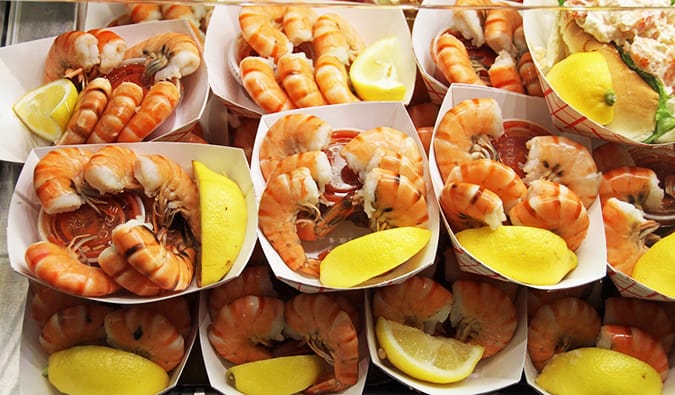
Quincy Market and next-door Faneuil Hall is the best place to stop and eat lunch on the Freedom Trail. There are about two dozen choices. You can get just about anything here, from Greek to sushi to sandwiches and much more. Since you’re in Boston, try the clam chowder, a local New England specialty.
After lunch, continue on the trail.
4 S Market St, +1 617-523-1300, faneuilhallmarketplace.com. Open Monday-Saturday 10am-9pm and Sunday 12pm-7pm.
Visiting Boston: Day 2
Boston Commons
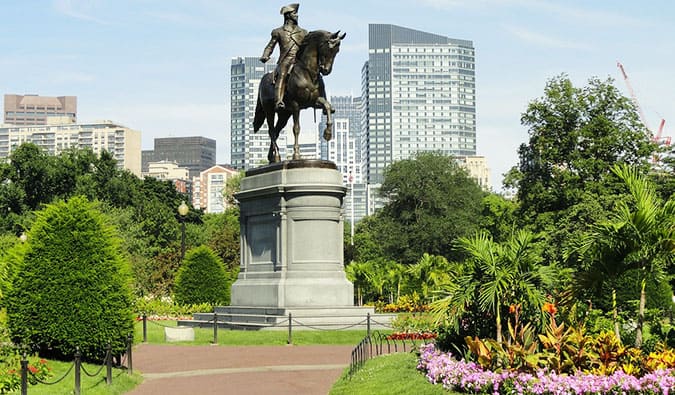
Start your day (again) in the Boston Commons, a giant park that sees plenty of people on warm summer days. There are lots of paths to take, as well as the Frog Pond, where kids and adults can cool off. During the winter, there’s skating on the pond. Boston Commons is a great place to go people-watching and get pictures of the skyline.
Boston Public Gardens

After your early-morning walk, head across the street to the Public Gardens. Opened in 1837, the area was actually a mudflat (a coastal wetland area) before it became a garden. The land was almost used for a cemetery as well, but the city decided to create the first public botanical garden instead. These days, you can take a swan boat on the pond in the middle of the gardens, or you can simply stroll around and see some pretty flowers.
Browse for Books

Located a stone’s throw away from the Boston Commons, Brattle Book Shop is a family-run used bookstore that dates back to 1825. It’s actually one of the oldest surviving bookstores in the country! It’s home to over 250,000 books, maps, postcards, and other odds and ends. In addition to used books, the store is also home to an impressive collection of first editions and antique books.
9 West Street, +1 617-542-0210, brattlebookshop.com. Open Monday-Saturday 9am-5:30pm.
Walk Around the Back Bay

This area used to be an actual bay. Before the Europeans arrived, the indigenous population used the tidal bay to catch fish, as the bay drained completely during low tide. When the land was colonized, a dam was built and the tidal bay was eventually filled in, creating the Back Bay area.
The end of the Public Gardens meets Boston’s Back Bay, our version of New York’s SoHo and West Village. This is where Boston’s elite and wealthy live, and nearby Newbury Street is our Madison Avenue, with lots of expensive shopping and high-end eateries. It’s a beautiful space to stroll around, with pretty brownstones and tree-lined streets. You can still see plenty of old Victorian homes in this neighborhood that date back to the 19th century.
Copley Square and Trinity Church
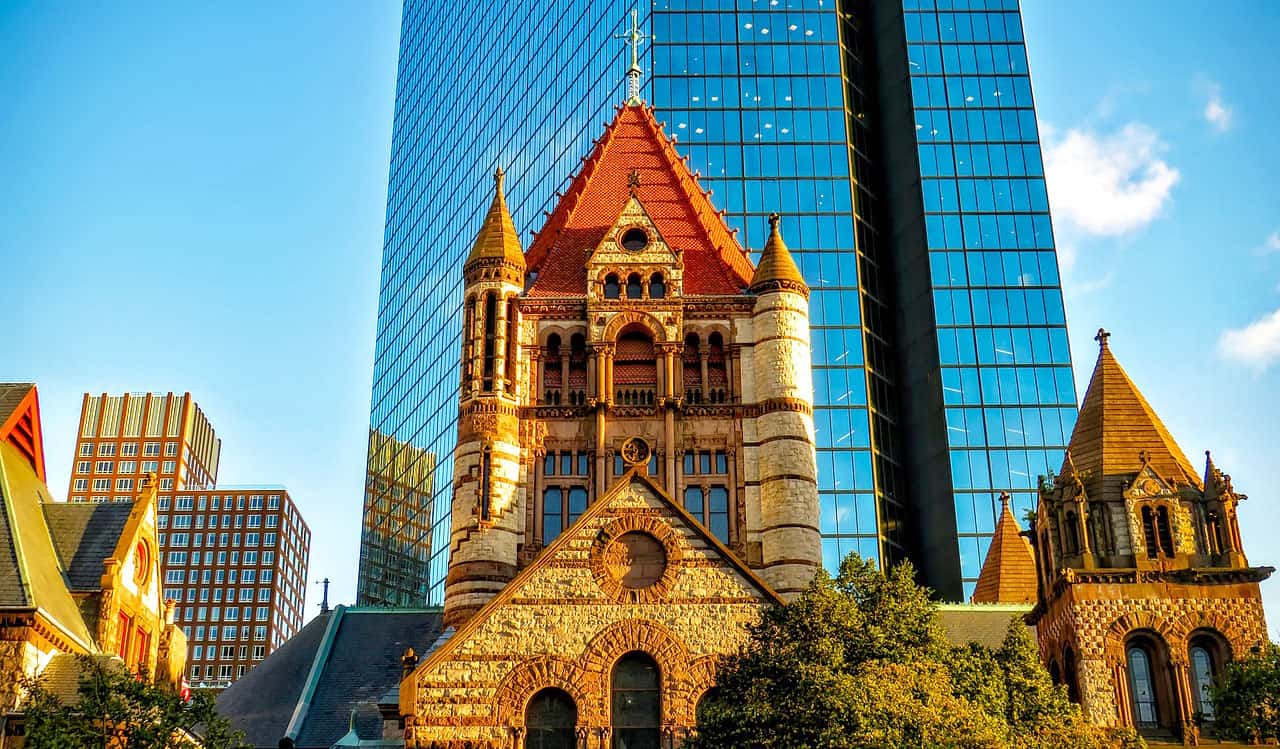
Copley Square is a great little park where you can buy discount theater tickets, listen to musicians, and gaze up at the Hancock Tower. You can also go into Boston’s Trinity Church, which is one of the city’s oldest and most beautiful. It was built in the 1870s after the original building burned down in the Great Fire of 1872. The style is known as Richardsonian Romanesque, which embraces the use of clay roofing, rough stones, and a massive tower. The style actually influenced churches all across the country upon its completion because it was so beautiful.
You’ll also find the Boston Public Library here. Opened in 1852, it’s one of the largest municipal libraries in the country, home to over 23 million items, with almost 4 million visitors each year.
206 Clarendon St, +1 617-536-0944, trinitychurchboston.org. The church is open for prayer and tours Tuesday-Saturday 10am-4:30pm and Sundays 12:15pm-4:30pm. Tours are $10 USD for adults, though it is free to enter for worship.
Head up to the Prudential Tower

Head back toward Copley to see the Prudential Tower, colloquially known as “The Pru.” You can actually go up to the top and get a bird’s-eye view of Boston. There are 52 floors in the building, which was built in the 1960s. These days, it’s the second tallest building in the city (the John Hancock Tower is first).
800 Boylston St, +1 617-859-0648, prudentialcenter.com. Open daily from 10am-8pm (10pm in the summer). Admission is $20 USD for adults, with discount available for students, seniors, and children.
Walk the Charles River

Double back toward the Charles River and walk the riverfront. If it’s summertime, you might be able to catch a free show at the Boston Hatch Shell or go sailing on the river. If not, it’s still a nice walk, where you’ll encounter runners, kids playing, and people playing sports.
47 David G. Mugar Way, +1 617-626-1250, hatchshell.com. See the website for an up-to-date list of events.
Visit the Museum of Science
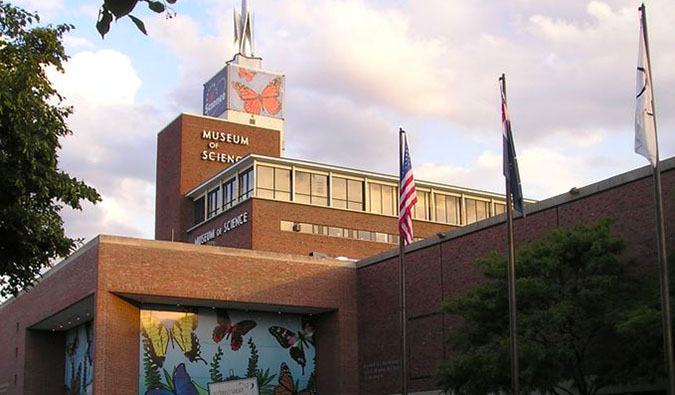
At the end of the riverfront is the Museum of Science. If you aren’t too tired, check out the museum and the Omni Theater inside. Though many of the exhibits are for kids, it’s still one of the best science museums in the country. The outer space exhibit is outstanding. Their permanent exhibits include displays showcasing dinosaurs, energy conservation, cartography, butterflies, wind and weather, nanotechnology, and space.
1 Science Park, +1 617-723-2500, mos.org. Open Saturday-Thursday 9am-5pm and Fridays 9am-9pm. Admission is $28 USD for adults, with discounts available for seniors and children.
Visiting Boston: Day 3
Visit the Aquarium

Boston’s aquarium is one of the best in the country. There are over 600 different species and over 20,000 animals here. You’ll see lionfish, penguins, eels, stingrays, and much, much more. It’s a great place to spend a few hours (especially if you are traveling with kids). It’s really well done — the fish aren’t all clustered into a few small tanks (the aquarium is over 75,000 square feet), and there’s a lot of information about how to protect the oceans.
1 Central Wharf, +1 617-973-5200, neaq.org. Open Monday-Friday 9am-5pm, weekends 9am-6pm. Admission is $27.95 USD for adults, with discounts available for kids and seniors.
Explore the North End
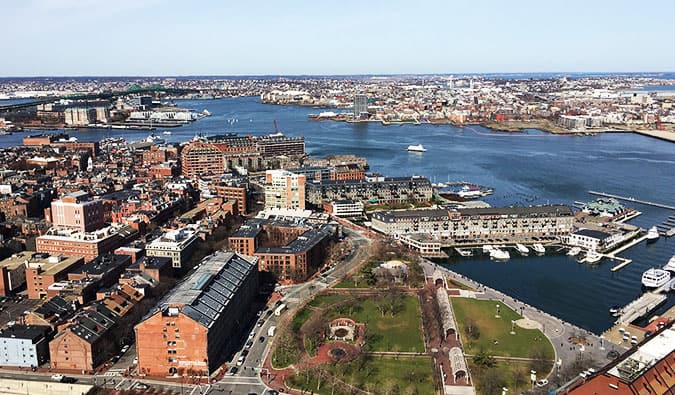
The historic North End is the heart of Boston’s Italian community. You’ll hear just as much Italian as you will Boston accents. In the morning, you’ll see little Italian grandmas shopping while the grandpas have their morning espresso. It’s almost like being in Italy. You’ll find the best gelato outside of Italy here.
See the Skinny House

When you’re in the North End, visit 44 Hull Street. Known as “the Skinny House” (or the Spite House), this incredibly narrow house has a rather interesting history. Built after the Civil War, it was a passion project of Joseph Euestus, who came home from the war to find that his brother had taken over more than half of the inherited land they were meant to share. Joseph decided to build on the remaining land — which his brother thought was too small to build anything on. Joseph went ahead and built a narrow four-story home on the small slice of land to block his brother’s view.
Visit an Art Gallery or Museum

Boston has a lot of great galleries and museums, so depending on your interest, you’ll want to check out some (or all) of the galleries and museums below. It will take more than an afternoon to see them all but you can always spread these visits out over a few days!
- Institute of Contemporary Art: If contemporary art is your cup of tea, this is for you. While it’s not my favorite style of art, I have to admit this place does put on some insightful exhibits. 25 Harbor Shore Drive, +1 617-478-3100, icaboston.org.
- Commonwealth Museum: This museum explores the history of Massachusetts. It’s actually really interesting and entirely underrated (especially if you’re a history nerd like me). 220 Morrissey Blvd, +1 617-727-2816, sec.state.ma.us/arc.
- Harvard Museum of Natural History: This natural history museum has exhibitions showcasing dinosaurs, animals, and minerals (including meteorites). It’s a great choice if you’re traveling with kids, though there is plenty of informative content for adults too! 26 Oxford St +1 617-495-3045, hmnh.harvard.edu.
- Harvard University Art Museums: Harvard actually has three art museums – the Fogg Museum, the Busch-Reisinger Museum, and the Arthur M. Sackler Museum. They are home to both modern and historical art exhibitions. See what exhibitions are running by checking their website. harvardartmuseums.org
- Museum of Fine Arts: This museum has an impressive collection of over 450,000 pieces of fine art. It also runs all sorts of art classes throughout the year, both multi-week classes as well as single-day workshops. If you’re looking to learn something new or improve your skills, check out the website for more details. 465 Huntington Avenue, +1 617-267-9300, mfa.org.
- Warren Anatomical Museum: Founded in 1847, this macabre museum is filled with Civil War–era medical tools as well as some unique (and perhaps unsettling) medical mysteries. It’s super weird but super neat. A definite must if you’re looking for an off-the-beaten-path museum! 10 Shattuck St, +1 617-432-6196, countway.harvard.edu/center-history-medicine/warren-anatomical-museum.
- Boston Tea Party and Ships Museum: This interactive museum is home to some historic ships that have been authentically restored to show you what life was like at sea during the Boston Tea Party. It also has a really informative documentary about the events that led up to the Tea Party and the American Revolution. Best of all, you can actually throw fake crates of tea into the river yourself to see what it was like! 306 Congress St, +1 617-338-1773, bostonteapartyship.com.
- Paul Revere House: Built in 1680, this is actually the oldest building in the entire city (it’s been renovated but it’s still the original building). The museum is filled with the family’s furniture and artifacts, giving you a sense of what life was like in Boston before the Revolution. 19 N Square, +1 617-523-2338, paulreverehouse.org.
- Museum of Bad Art: The name says it all! This is a museum filled with terrible art. The MOBA has rotating exhibits throughout the year, so there is always something new and terrible to behold. If you feel like a laugh, definitely check out this quirky gallery! 55 Davis Square, +1 781-444-6757, museumofbadart.org.
- Isabella Stewart Gardner MuseumThis museum is home to an amazing art collection of over 20,000 items, including European, Asian, and American art. Opened in 1903, the museum is made up of a wide-ranging collection of paintings, tapestries, decorative arts, and sculptures. It’s one of the best museums in Boston. Don’t miss it.25 Evans Way, +1 617-566-1401, gardnermuseum.org.
Visiting Boston: Day 4
Take a Free Tour of Harvard
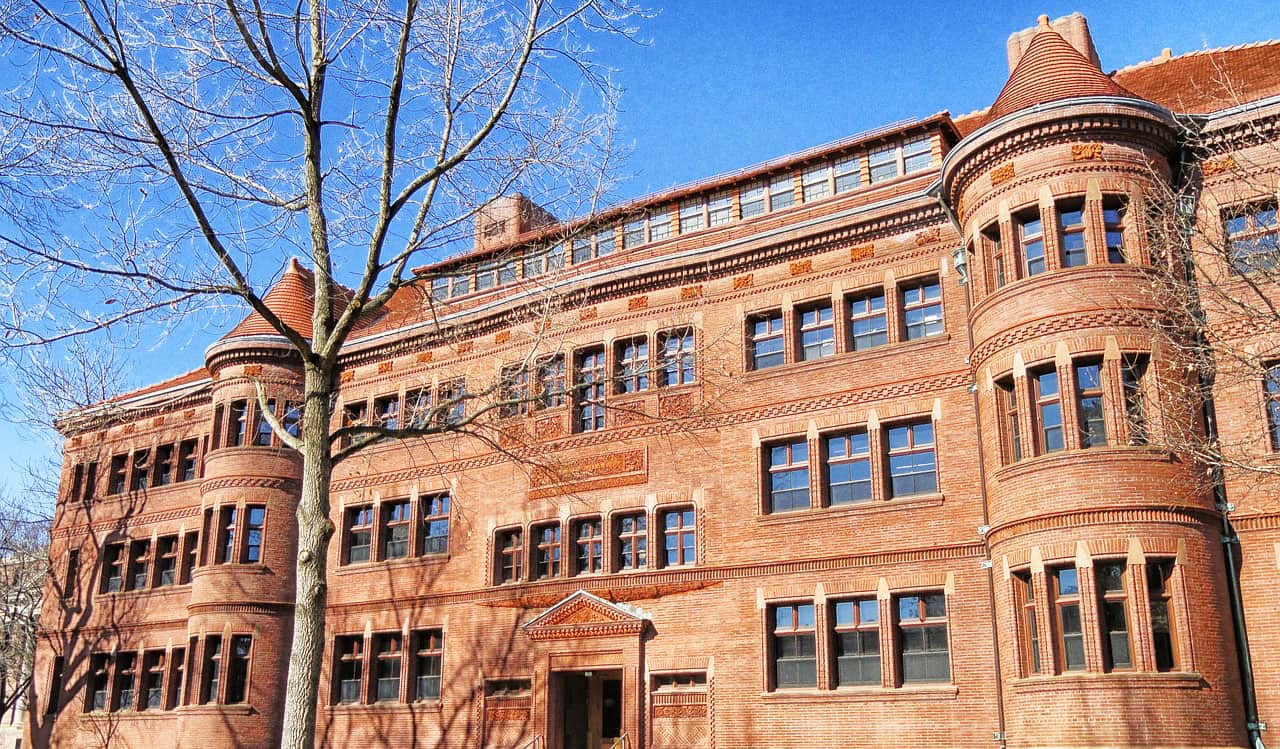
Founded in 1636, Harvard is the oldest university in America. Head to its home in Cambridge (Harvard Square train stop on the Red Line) and join a free tour. Learn about the university’s history, architecture, programs, and myths.
Harvard University, +1 617-495-1000, harvard.edu/on-campus/visit-harvard/tours.
Hang Out in Harvard Square
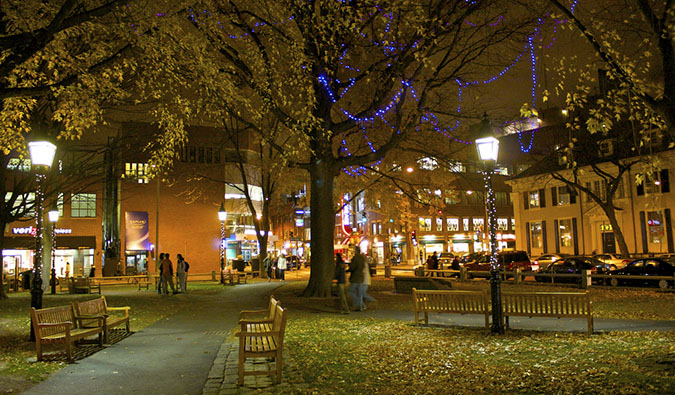
When you’re finished, wander around and experience Harvard Square’s eclectic offerings. There are a lot of good street musicians to listen to (Tracy Chapman got her start here). See the mix of life in Harvard Square: walk around, stroll into used bookstores and coffee shops, and watch artists, vagabonds, locals, and college students mingle. There are some cool little shops in “The Garage.”
Arnold Arboretum
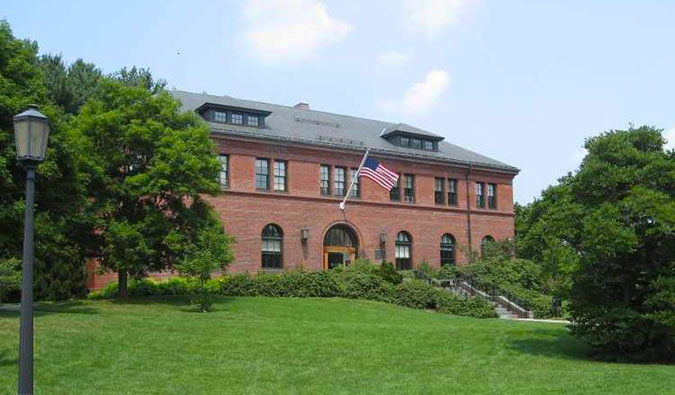
Over 260 acres of free public space are open from sunrise to sunset. There are running trails, gardens, open lawns, and tons of flowers from all over the world. Relax among the plants and take a step back from the fast pace of the city. This place is much quieter than the Public Gardens and offers a wider variety of plant life. It also has a great bonsai tree collection. This is located a little outside the city, so it will take time to get to!
125 Arborway, +1 617-524-1718, arboretum.harvard.edu. Open daily 7am-7pm. Admission is free.
Take the Sam Adams Brewery Tour

After four days of sightseeing, you deserve a beer or five. Luckily, this brewery is located near the Arboretum so it’s easy to visit and a great way to end your day. Sam Adams is a major brewer in Boston, and locals drink it widely and frequently. The brewery offers free tours, starting in mid-afternoon and departing every 45 minutes. You get a few free samples along the way. If you’re under 21, don’t worry. You can still go — you just can’t drink.
30 Germania St, +1 617-368-5080, samueladams.com. Tours are available Monday-Thursday and Saturdays 10am-3pm. On Friday, tours are available between 10am and 5:30pm.
See the Red Sox Play
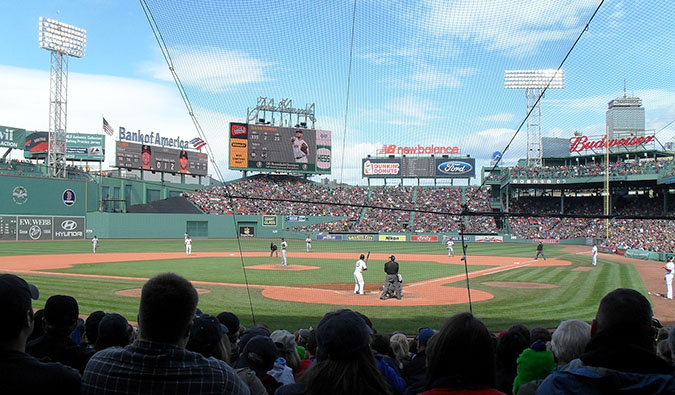
Boston is a sports town, and Bostonians are die-hard about their teams, so you’re sure to witness some intense feelings when you attend a game. If you really want a Boston sports experience, go to a Red Sox game. If you can’t get in, hang out around the bars near Fenway. Just never, ever, ever root for the Yankees! While there be sure to visit Bleacher Bar. Opened in 2008, you can actually look out onto the field from the bar itself. It’s a good spot to watch the game if you don’t have a ticket to the game.
4 Yawkey Way, +1 877-733-7699, mlb.com/redsox/ballpark. See the website for an up-to-date schedule.
(The Sox not in season? No worries. We have the Bruins, Celtics, and Patriots. No matter the time of year, you’ll be able to find a game to see!)
Visiting Boston: Day 5
Explore the Black Heritage Trail
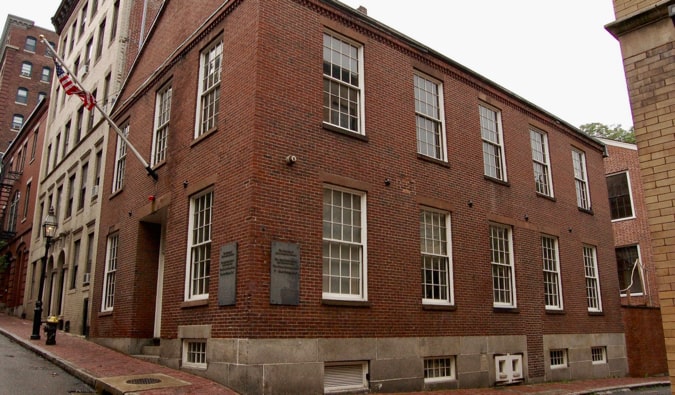
Much like the Freedom Trail, the Black Heritage Trail comprises 14 sites located around Beacon Hill that highlight important parts of African-American history in Boston. Massachusetts was actually the first state to declare slavery illegal (in 1783), and you can learn a lot about the history of slavery and the African-American experience by walking the trail. If you want to do a self-guided tour, free maps are available at the Abiel Smith School. There are several companies that also arrange guided tours (with the map it’s very simple to do yourself, though).
Visit the Children’s Museum

If you’re traveling with kids, this is a great place to spend part of your visit. It’s the second oldest children’s museum in the US and has permanent exhibits on health and exercise, construction, space, art, and diversity. It also has a real two-story house from Kyoto, Japan, that teaches kids about life there (it’s actually pretty cool!).
308 Congress Street, +1 617-426-6500, bostonchildrensmuseum.org. Open daily 10am-5pm (9pm on Fridays). Admission is $17 USD for both adults and kids (free for infants under 12 months).
See the USS Constitution
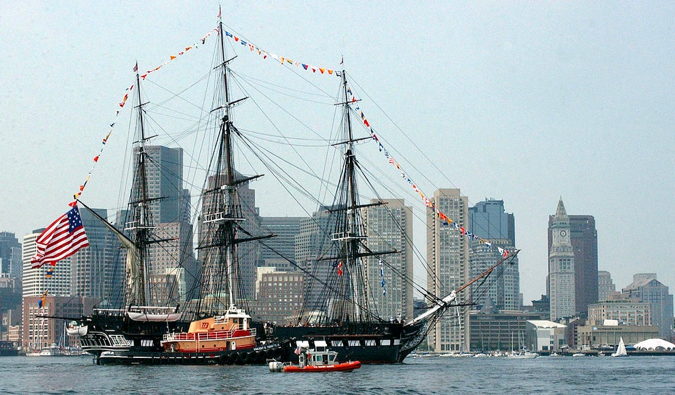
The USS Constitution was commissioned in 1797. The ship was actually named by George Washington and was used in the War of 1812 (and later in the Civil War). It’s the oldest ship in the world that is still afloat, permanently docked in the harbor. If you want to do more than just look at it (you’ll see it on the Freedom Trail), free tours are offered every 30 minutes and they are a great way to get a sense of what life at sea was life over 200 years ago!
Charlestown Navy Yard, +1 617-426-1812, ussconstitutionmuseum.org. The ship is open daily 10am-4pm (with extended hours in the summer); the museum is open 10am-5pm (with extended hours in the summer as well). Admission is free, though the museum has a suggested donation of $10-15.
Visit More Museums – With any extra time, visit more museums! There’s plenty of them to see! Try not to skip the big ones!
Go Stargazing

Every Wednesday, The Coit Observatory at Boston University offers free stargazing (weather permitting). It’s a really cool way to learn a bit about astronomy and fun for both children and adults (though minors need to be accompanied by an adult). Just make sure to dress for the weather, since you’ll be stargazing outside. Since the weather can be fickle, you’ll want to call ahead to make sure the stargazing is happening. Space is limited so you need to reserve your spot in advance.
725 Commonwealth Avenue, +1 617-353-2630, bu.edu/astronomy/events/public-open-night-at-the-observatory. Viewings are Wednesday evenings at 7:30pm in the autumn and winter and 8:30pm in the spring and summer.
5 Other Things to See and Do in Boston
If you’re looking for more things to do or different suggestions than above, here are some other cool things to do in Boston to add to your itinerary:
See the Mapparium – Located in the Mary Baker Eddy Library, this three-story inverted globe serves as a giant map of the world that you can walk into via a glass bridge. It is constructed of over 600 stained-glass panels and shows the world as it looked in 1935.
200 Massachusetts Avenue, +1 617-450-7000, marybakereddylibrary.org. Open daily 10am-5pm. Admission to the Mapparium is $6 USD for adults, with discounts available for students, children, and seniors.
Head to Castle Island – Castle Island is located in South Boston and is famous for Fort Independence. When the fort was no longer needed for defense, it was actually used as the first state prison. The island covers 22 acres and has excellent beaches, as well as some running trails that are popular with the locals. There’s also an area for picnics and you can visit the old fort for free. The place gets pretty busy on the weekends during the summer, and you can often see school groups exploring the fort during the spring.
Relax at the Lawn on D – This massive green space is new to the city (when I was growing up, there was nothing in this area so you would never go there). There are all sorts of free activities happening year-round, from concerts to festivities and everything in between! There’s public seating, free Wi-Fi, art exhibitions, and a few games, like table tennis and bocce. To see what events are happening during your visit, check the website for details.
420 D St, +1 877-393-3393, signatureboston.com/lawn-on-d. Open daily 7am-10pm (hours may vary for events). Admission is free.
Hike the Blue Hills – This park is a bit out of the way, but it’s definitely worth a visit if you want to get out and stretch your legs. The 7,000-acre park is home to over 100 miles of trails and offers some picturesque viewpoints. There are also plenty of activities to keep you entertained, such as boating, fishing, skiing, and rock climbing (depending on the season). It can get busy in the summer on the weekends, so just be sure to arrive early.
Tour the Custom House – Built in the 17th century, the Custom House is one of the most recognizable buildings in the city. In 1915, a tower was added to the building, making it the tallest building in the city at the time. The building is owned by Marriott Hotels now, though you can still take a free tour (by appointment) to go up to the observation deck on the 26th floor.
3 McKinley Square, +1 617-310-6300, marriott.com/hotels/travel/bosch-marriott-vacation-club-pulse-at-custom-house-boston. Tours available Sunday-Friday 10am-4pm. Tours are free though they are by appointment only.
Take a Walking Tour – In addition to free walking tours, there are also tons of paid options if you want something more in-depth. Food tours, wine tours, historical tours — you name it, the city has it! Here are a few worth checking out if you’re looking to take a tour:
***
Boston is a great city (and I’m not just saying that because I grew up there). I’ve never encountered a person who hasn’t liked it. This Boston visitor’s itinerary will give you a good overview of the city at a nice, relaxing pace. You’ll be moving around a lot, though, so make sure you get an unlimited “T” pass (subway/train pass). If you have more time, you can squeeze in
some other activities.
But why rush such a beautiful place?
Take it slow. Mix and match the itinerary to suit your needs but this is how I’d structure my days if I was visiting Boston!
Book Your Trip to Boston: Logistical Tips and Tricks
Book Your Flight
Find a cheap flight by using Skyscanner or Momondo. They are my two favorite search engines, because they search websites and airlines around the globe, so you always know no stone is being left unturned.
Book Your Accommodation
You can book your hostel with Hostelworld. If you want to stay somewhere other than a hostel, use Booking.com, as it consistently returns the cheapest rates for guesthouses and cheap hotels. I use it all the time. My favorite hostel to stay at in Boston is:
- HI Boston – This hostel is in a great location, has a spacious common area and a café, and the staff is super friendly and helpful.
Don’t Forget Travel Insurance
Travel insurance will protect you against illness, injury, theft, and cancellations. It’s comprehensive protection in case anything goes wrong. I never go on a trip without it, as I’ve had to use it many times in the past. I’ve been using World Nomads for ten years. My favorite companies that offer the best service and value are:
Looking for the best companies to save money with?
Check out my resource page for the best companies to use when you travel! I list all the ones I use — and I think they will help you too!
Looking for more information on visiting Boston?
Check out my in-depth destination guide to Boston with more tips on what to see and do, costs, ways to save, and much, much more!
Photo credits: 6, 7, 7, 8, 15, 16, 18, 21, 22, 23, 25
The post How to Spend Five Days in Boston appeared first on Nomadic Matt's Travel Site.
 Posted: 01/27/2020 | January 27th, 2020
In 2010, I decided to spend the summer in NYC. I was two years into blogging and was making enough where I could afford a few months here. Still new to the industry, NYC was where all the legends of writing lived and I wanted to start making connections with my peers.
It was that summer I met Jason Cochran, a guidebook writer from Frommers, editor, and the man I would consider my mentor.
Though we never had any formal mentor/mentee relationship, Jason’s writing philosophy, advice, and feedback, especially on my first book, How to Travel the World on $50 a Day, has been instrumental in shaping me as a writer. Much of his philosophy has become mine and I don’t think I would have grown to where I am without him.
Last year, he finally published the book he’d been working on about tourism in America, called Here Lies America. (We featured it on our best books of 2019 list).
Today, we’re going to go behind the scenes of the book and talk to Jason on what does lie in America!
Nomadic Matt: Tell everyone about yourself.
Jason Cochran: I’ve been a travel writer for longer than I’ve felt like an adult. In the mid-‘90s, I kept a very early form of a travel blog on a two-year backpacking trip around the world. That blog became a career. I’ve written for more publications than I can count, including for a prime-time game show.
These days I’m the Editor-in-Chief of Frommers.com, where I also write two of its annual guidebooks, and I co-host a weekly radio show with Pauline Frommer on WABC. For me, history is always my way into a new place. In many ways, time is a form of travel, and understanding the past flexes a lot of the same intellectual muscles as understanding cultural differences.
So I have come to call myself a travel writer and a pop historian. That last term is something I just made up. Dan Rather made fun of me once for it. “Whatever that is,” he said. But it seems to fit. I like uncovering everyday history in ways that are funny, revealing, and casual, the way Bill Bryson and Sarah Vowell do.
What made you want to write this book?
Before I began researching, I just thought it would be funny. You know, sarcastic and ironic, about Americans going to graveyards and places of suffering just to buy lots of tacky souvenirs, eat ice cream, and wear dumb t-shirts. And, that’s still in there, for sure. We’re Americans and we like those things. Key chains will happen.
But that changed fast. For one, that would have become a very tired joke. It wouldn’t carry for three hundred pages. Things clicked for me early on, on the first of several cross-country research drives I took. I went to a place that I wasn’t taught about at school, and it clicked. I was at Andersonville in rural Georgia, where 13,000 out of 45,000 Civil War prisoners died in just 14 months. It was flat-out a concentration camp.
Yes, it turns out that concentration camps are as American as apple pie. The man who ran it was the only Confederate officer who was executed after the war. Southerners feared the victors would hang their leaders by the dozen, but that vengeance never materialized. Not for Jefferson Davis, not for Robert E. Lee—the guy who ran this camp poorly got the only public hanging. And he wasn’t even a born American. He was Swiss!
But that’s how important this place was at the time. Yet most of us have never even heard of it, except for a really bad low-budget movie on TNT in the ‘90s in which all the characters bellowed inspirational monologues as if they thought they were remaking Hoosiers.
So just getting my head around the full insanity of Andersonville’s existence was a big light bulb—our history is constantly undergoing whitewashing. Americans are always willfully trying to forget how violent and awful we can be to each other.
And Andersonville wasn’t even the only concentration camp in that war. There were a bunch in both the North and the South, and most of them had survival rates that were just as dismal. So that was another light bulb: There’s a story in why our society decided to preserve Andersonville but forget about a place like Chicago’s Camp Douglas, which was really just as nasty, except now it’s a high-rise housing project and there’s a Taco Bell and a frozen custard place where its gate once stood.
And did you know that the remains of 12,000 people from another Revolutionary War concentration camp are in a forgotten grave smack in the middle of Brooklyn? We think our major historic sites are sacred and that they are the pillars of our proud American story, but actually, how accurate can our sites be if they’re not even fairly chosen?
Posted: 01/27/2020 | January 27th, 2020
In 2010, I decided to spend the summer in NYC. I was two years into blogging and was making enough where I could afford a few months here. Still new to the industry, NYC was where all the legends of writing lived and I wanted to start making connections with my peers.
It was that summer I met Jason Cochran, a guidebook writer from Frommers, editor, and the man I would consider my mentor.
Though we never had any formal mentor/mentee relationship, Jason’s writing philosophy, advice, and feedback, especially on my first book, How to Travel the World on $50 a Day, has been instrumental in shaping me as a writer. Much of his philosophy has become mine and I don’t think I would have grown to where I am without him.
Last year, he finally published the book he’d been working on about tourism in America, called Here Lies America. (We featured it on our best books of 2019 list).
Today, we’re going to go behind the scenes of the book and talk to Jason on what does lie in America!
Nomadic Matt: Tell everyone about yourself.
Jason Cochran: I’ve been a travel writer for longer than I’ve felt like an adult. In the mid-‘90s, I kept a very early form of a travel blog on a two-year backpacking trip around the world. That blog became a career. I’ve written for more publications than I can count, including for a prime-time game show.
These days I’m the Editor-in-Chief of Frommers.com, where I also write two of its annual guidebooks, and I co-host a weekly radio show with Pauline Frommer on WABC. For me, history is always my way into a new place. In many ways, time is a form of travel, and understanding the past flexes a lot of the same intellectual muscles as understanding cultural differences.
So I have come to call myself a travel writer and a pop historian. That last term is something I just made up. Dan Rather made fun of me once for it. “Whatever that is,” he said. But it seems to fit. I like uncovering everyday history in ways that are funny, revealing, and casual, the way Bill Bryson and Sarah Vowell do.
What made you want to write this book?
Before I began researching, I just thought it would be funny. You know, sarcastic and ironic, about Americans going to graveyards and places of suffering just to buy lots of tacky souvenirs, eat ice cream, and wear dumb t-shirts. And, that’s still in there, for sure. We’re Americans and we like those things. Key chains will happen.
But that changed fast. For one, that would have become a very tired joke. It wouldn’t carry for three hundred pages. Things clicked for me early on, on the first of several cross-country research drives I took. I went to a place that I wasn’t taught about at school, and it clicked. I was at Andersonville in rural Georgia, where 13,000 out of 45,000 Civil War prisoners died in just 14 months. It was flat-out a concentration camp.
Yes, it turns out that concentration camps are as American as apple pie. The man who ran it was the only Confederate officer who was executed after the war. Southerners feared the victors would hang their leaders by the dozen, but that vengeance never materialized. Not for Jefferson Davis, not for Robert E. Lee—the guy who ran this camp poorly got the only public hanging. And he wasn’t even a born American. He was Swiss!
But that’s how important this place was at the time. Yet most of us have never even heard of it, except for a really bad low-budget movie on TNT in the ‘90s in which all the characters bellowed inspirational monologues as if they thought they were remaking Hoosiers.
So just getting my head around the full insanity of Andersonville’s existence was a big light bulb—our history is constantly undergoing whitewashing. Americans are always willfully trying to forget how violent and awful we can be to each other.
And Andersonville wasn’t even the only concentration camp in that war. There were a bunch in both the North and the South, and most of them had survival rates that were just as dismal. So that was another light bulb: There’s a story in why our society decided to preserve Andersonville but forget about a place like Chicago’s Camp Douglas, which was really just as nasty, except now it’s a high-rise housing project and there’s a Taco Bell and a frozen custard place where its gate once stood.
And did you know that the remains of 12,000 people from another Revolutionary War concentration camp are in a forgotten grave smack in the middle of Brooklyn? We think our major historic sites are sacred and that they are the pillars of our proud American story, but actually, how accurate can our sites be if they’re not even fairly chosen?
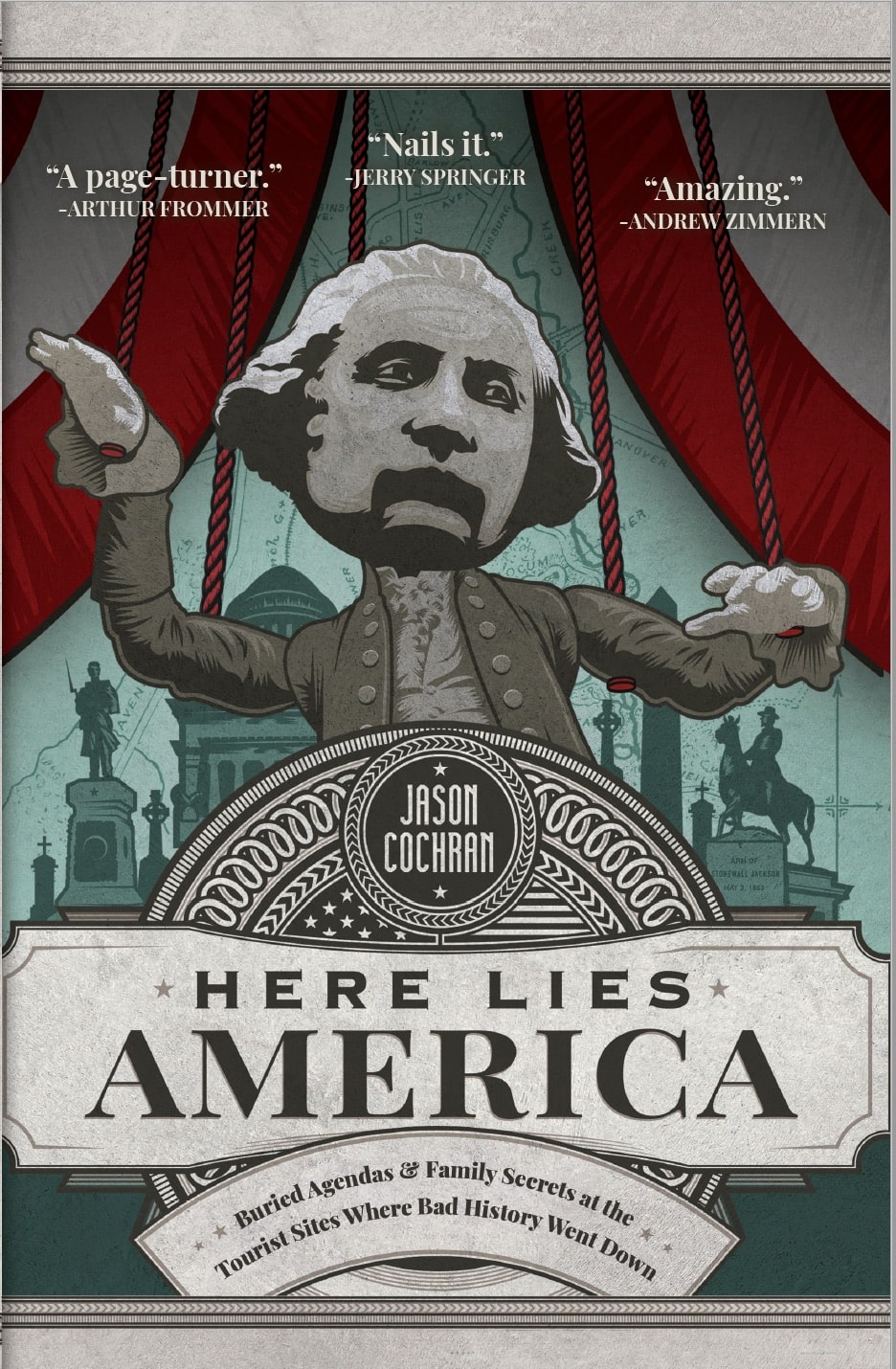 What was one of the most surprising things you learned from your research?
In almost no instance was a plaque, statue, or sign placed right after the historic event in question. Most of the monuments were actually installed many decades after the event. In the case of the Civil War, most of the memorials were erected in a boom that came a half-century after the last bullet was fired.
If you really get close to the plaques and read past the poetic inscriptions, it quickly becomes clear that our most beloved historic sites aren’t sanctified with artifacts but with propaganda placed there by people who weren’t even witnesses to the event. There was a vast network of women’s clubs that would help you order a statue for your own town out of a catalog, and they commissioned European sculptors who cashed the checks but privately grumbled about the poor taste of the tacky kitsch they were installing all over America.
We’re still dealing with what they did today. It’s what Charlottesville was about. But most people don’t realize these statues weren’t put there anywhere near the time of the war, or that they were the product of an orchestrated public relations machine. By powerful women!
What was one of the most surprising things you learned from your research?
In almost no instance was a plaque, statue, or sign placed right after the historic event in question. Most of the monuments were actually installed many decades after the event. In the case of the Civil War, most of the memorials were erected in a boom that came a half-century after the last bullet was fired.
If you really get close to the plaques and read past the poetic inscriptions, it quickly becomes clear that our most beloved historic sites aren’t sanctified with artifacts but with propaganda placed there by people who weren’t even witnesses to the event. There was a vast network of women’s clubs that would help you order a statue for your own town out of a catalog, and they commissioned European sculptors who cashed the checks but privately grumbled about the poor taste of the tacky kitsch they were installing all over America.
We’re still dealing with what they did today. It’s what Charlottesville was about. But most people don’t realize these statues weren’t put there anywhere near the time of the war, or that they were the product of an orchestrated public relations machine. By powerful women!
 I wrote a line in the book: “Having a Southern heritage is like having herpes—you can forget you have it, you can deny it, but it inevitably bubbles up and requires attention.” These issues aren’t going away.
Places we think of as holy ground, like Arlington National Cemetery, often have some pretty shocking origin stories. Arlington started because some guy got pissed off at Robert E. Lee and started buying corpses in his rose garden to get back at him! That’s our hallowed national burial ground: a nasty practical joke, like the Burn Book from Mean Girls. Dig a little and you find more revolting secrets, like how the incredible number of people buried under the wrong headstone, or the time the government put the remains of a Vietnam soldier in the Tomb of the Unknowns. They pretty much knew his identity, but Ronald Reagan really wanted a TV photo op. So they sealed all the soldier’s belongings in the coffin with him so that no one would figure it out.
They eventually had to admit they’d lied and gave the soldier’s body back to his mom. But if a thing like that happens in a place like Arlington, can the rest of our supposedly sacred sites be taken at face value at all?
It goes a lot deeper. At Ford’s Theatre and the surrender house at Appomattox, the site we visit isn’t even real. They’re fakes! The original buildings are long gone but visitors are rarely told that. The tale’s moral is what’s valued, not the authenticity.
What can visiting these sites teach us about how we remember our past?
Once you realize that all historic sites have been cultivated by someone who wanted to define your understanding of it, you learn how to use critical thinking as a traveler. All it takes is asking questions. One of the most fun threads in the book kicks off when I go to Oakland, a historic but touristy cemetery in Atlanta. I spot an ignored gravestone that piqued my interest. I’d never heard of the name of the woman: Orelia Key Bell. The info desk didn’t have her listed among the notable graves. She was born around the 1860s, which was a very eventful time in Atlanta.
So I took out my phone and right there on her grave, I Googled her. I researched her whole life so I could appreciate what I was seeing. It turned out she was a major poet of her time. I stood there reading PDFs of her books at her feet. Granted, her stuff was dreary, painfully old-fashioned. I wrote that her style of writing didn’t fall out of fashion so much as it was yanked down and clubbed by Hemingway.
But reading her writing at her grave made me feel wildly connected to the past. We almost never go to old places and look deeper. We usually let things remain dead. We accept what’s on the sign or the plaque as gospel, and I’m telling you, almost nothing ever reaches us in a state of purity.
I wrote a line in the book: “Having a Southern heritage is like having herpes—you can forget you have it, you can deny it, but it inevitably bubbles up and requires attention.” These issues aren’t going away.
Places we think of as holy ground, like Arlington National Cemetery, often have some pretty shocking origin stories. Arlington started because some guy got pissed off at Robert E. Lee and started buying corpses in his rose garden to get back at him! That’s our hallowed national burial ground: a nasty practical joke, like the Burn Book from Mean Girls. Dig a little and you find more revolting secrets, like how the incredible number of people buried under the wrong headstone, or the time the government put the remains of a Vietnam soldier in the Tomb of the Unknowns. They pretty much knew his identity, but Ronald Reagan really wanted a TV photo op. So they sealed all the soldier’s belongings in the coffin with him so that no one would figure it out.
They eventually had to admit they’d lied and gave the soldier’s body back to his mom. But if a thing like that happens in a place like Arlington, can the rest of our supposedly sacred sites be taken at face value at all?
It goes a lot deeper. At Ford’s Theatre and the surrender house at Appomattox, the site we visit isn’t even real. They’re fakes! The original buildings are long gone but visitors are rarely told that. The tale’s moral is what’s valued, not the authenticity.
What can visiting these sites teach us about how we remember our past?
Once you realize that all historic sites have been cultivated by someone who wanted to define your understanding of it, you learn how to use critical thinking as a traveler. All it takes is asking questions. One of the most fun threads in the book kicks off when I go to Oakland, a historic but touristy cemetery in Atlanta. I spot an ignored gravestone that piqued my interest. I’d never heard of the name of the woman: Orelia Key Bell. The info desk didn’t have her listed among the notable graves. She was born around the 1860s, which was a very eventful time in Atlanta.
So I took out my phone and right there on her grave, I Googled her. I researched her whole life so I could appreciate what I was seeing. It turned out she was a major poet of her time. I stood there reading PDFs of her books at her feet. Granted, her stuff was dreary, painfully old-fashioned. I wrote that her style of writing didn’t fall out of fashion so much as it was yanked down and clubbed by Hemingway.
But reading her writing at her grave made me feel wildly connected to the past. We almost never go to old places and look deeper. We usually let things remain dead. We accept what’s on the sign or the plaque as gospel, and I’m telling you, almost nothing ever reaches us in a state of purity.
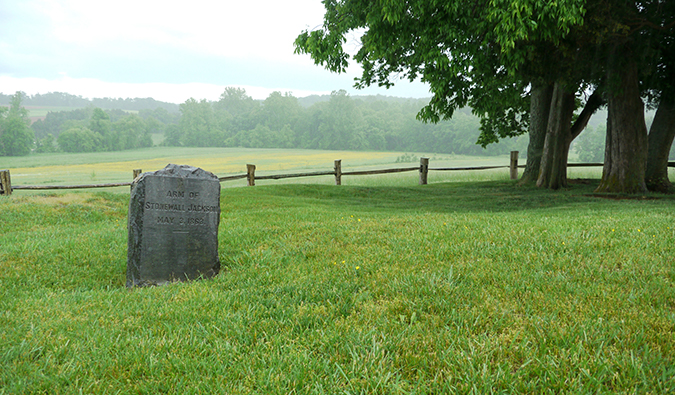 I figured that if I was going to probe all these strangers, I had to be fair and probe someone I knew. I decided to look into an untimely death in my own family, a great-grandfather who had died in a train wreck in 1909. That was the beginning and the end of the tale in my family: “Your great-great grandfather died in a train wreck up in Toccoa.”
But almost as soon as I started looking deeper, I discovered something truly shocking—he had been murdered. Two young Black men were accused in rural South Carolina for sabotaging his train and killing him. You’d think at least someone in my family would have known this! But no one had ever looked into it before!
Here Lies America follows their trail. Who were these guys? Why would they want to kill him? I went to where their village used to be, I started digging into court documents from their murder trial. Let me tell you, the shockers came flooding. Like, I found they may have killed him because they wanted to protect a sacred old Cherokee burial mound from destruction. There was this crazy, larger-than-life forgotten story happening in my own damn family.
My experience with that poet’s grave has a happy coda. Last week, someone told me that Orelia Key Bell and her companion are now officially part of the guided tour of Oakland. The simple act of looking deeper had revived a forgotten life and put her back on the record. That’s what visiting these sites can do—but you have to look behind the veneer, the way I do with dozens of attractions in my book. This is the essence of travel, isn’t it? Getting to a core understanding of the truth of a place.
A lot of what you wrote showed how whitewashed many of these historical sites are. How do we as travelers dig deeper to get to the real history?
Remember that pretty much everything you see at a historic site or museum was intentionally placed there or left there by someone. Ask yourself why. Ask who. And definitely ask when, because the climate of later years often twists interpretation of the past. It’s basic content analysis, really, which is something we’re really bad at in a consumer society.
Americans have it drilled into them to never question the tropes of our patriotism. If we learned about in grade school, we assume it’s a settled matter, and if you press it, you’re somehow an insurgent. Now, more than any other time in history, it’s easier than ever to call up primary sources about any era you want. If you want to go back to what our society really is, if you want to try to figure out how we wandered into the shattered shambles we’re in today, you have to be honest about the forces that created the image that, until recently, many of us believed we really were.
I figured that if I was going to probe all these strangers, I had to be fair and probe someone I knew. I decided to look into an untimely death in my own family, a great-grandfather who had died in a train wreck in 1909. That was the beginning and the end of the tale in my family: “Your great-great grandfather died in a train wreck up in Toccoa.”
But almost as soon as I started looking deeper, I discovered something truly shocking—he had been murdered. Two young Black men were accused in rural South Carolina for sabotaging his train and killing him. You’d think at least someone in my family would have known this! But no one had ever looked into it before!
Here Lies America follows their trail. Who were these guys? Why would they want to kill him? I went to where their village used to be, I started digging into court documents from their murder trial. Let me tell you, the shockers came flooding. Like, I found they may have killed him because they wanted to protect a sacred old Cherokee burial mound from destruction. There was this crazy, larger-than-life forgotten story happening in my own damn family.
My experience with that poet’s grave has a happy coda. Last week, someone told me that Orelia Key Bell and her companion are now officially part of the guided tour of Oakland. The simple act of looking deeper had revived a forgotten life and put her back on the record. That’s what visiting these sites can do—but you have to look behind the veneer, the way I do with dozens of attractions in my book. This is the essence of travel, isn’t it? Getting to a core understanding of the truth of a place.
A lot of what you wrote showed how whitewashed many of these historical sites are. How do we as travelers dig deeper to get to the real history?
Remember that pretty much everything you see at a historic site or museum was intentionally placed there or left there by someone. Ask yourself why. Ask who. And definitely ask when, because the climate of later years often twists interpretation of the past. It’s basic content analysis, really, which is something we’re really bad at in a consumer society.
Americans have it drilled into them to never question the tropes of our patriotism. If we learned about in grade school, we assume it’s a settled matter, and if you press it, you’re somehow an insurgent. Now, more than any other time in history, it’s easier than ever to call up primary sources about any era you want. If you want to go back to what our society really is, if you want to try to figure out how we wandered into the shattered shambles we’re in today, you have to be honest about the forces that created the image that, until recently, many of us believed we really were.
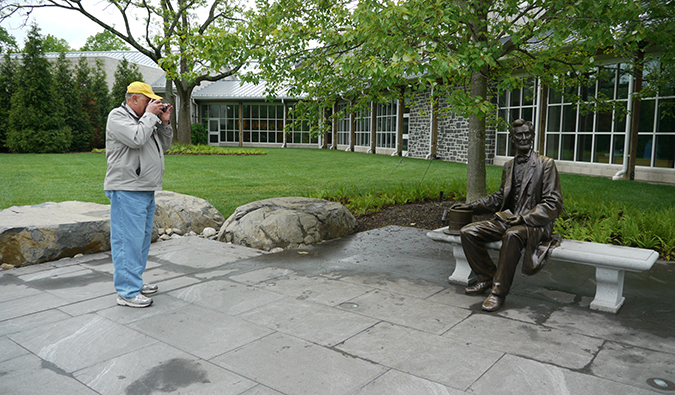 Do you think Americans have a problem talking about their history? If so, why is that?
There’s a phrase, and I forget who said it—maybe James Baldwin?-but it goes, “Americans are better at thinking with their feelings than about them.” We go by feels, not so much by facts. We do love to cling to a tidy mythology of how free and wonderful our country always was. It reassures us. We probably need it. After all, in America, where we all come from different places, our national self-belief is our main cultural glue. So we can’t resist prettying up the horrible things we do.
But make no mistake: Violence was the foundation of power in the 1800s, and violence is still a foundation of our values and entertainment today. We have yet to come to terms with that. Our way of dealing with violence is usually to convince ourselves it’s noble.
And if we can’t make pain noble, we try to erase it. It’s why the place where McKinley was shot, in Buffalo, lies under a road now. That was intentional so that it would be forgotten by anarchists. McKinley was given no significant pilgrimage spot where he died, but right after that death, his fans paid for a monument by Burnside’s Bridge in Antietam, because as a youth, he once served coffee to soldiers.
That’s the reason: “personally and without orders served hot coffee,” it reads—it’s hilarious. That is our national mythmaking in a nutshell: Don’t pay attention to the place that raises tough questions about imperialism and economic disparity, but put up an expensive tribute to a barista.
What is the main takeaway you’d like readers to take away from your book?
You may not know where you came from as well as you think you do. And we as a society definitely haven’t asked enough questions about who shaped the information we grew up with. Americans are finally ready to hear some truth.
Jason Cochran is the author of Here Lies America: Buried Agendas and Family Secrets at the Tourist Sites Where Bad History Went Down. He’s been a writer since mid-1990s, a commentator on CBS and AOL, and works today as editor-in-chief of Frommers.com and as co-host of the Frommer Travel Show on WABC. Jason was twice awarded “Guide Book of the Year” by the Lowell Thomas Awards and the North American Travel Journalists Association.
Do you think Americans have a problem talking about their history? If so, why is that?
There’s a phrase, and I forget who said it—maybe James Baldwin?-but it goes, “Americans are better at thinking with their feelings than about them.” We go by feels, not so much by facts. We do love to cling to a tidy mythology of how free and wonderful our country always was. It reassures us. We probably need it. After all, in America, where we all come from different places, our national self-belief is our main cultural glue. So we can’t resist prettying up the horrible things we do.
But make no mistake: Violence was the foundation of power in the 1800s, and violence is still a foundation of our values and entertainment today. We have yet to come to terms with that. Our way of dealing with violence is usually to convince ourselves it’s noble.
And if we can’t make pain noble, we try to erase it. It’s why the place where McKinley was shot, in Buffalo, lies under a road now. That was intentional so that it would be forgotten by anarchists. McKinley was given no significant pilgrimage spot where he died, but right after that death, his fans paid for a monument by Burnside’s Bridge in Antietam, because as a youth, he once served coffee to soldiers.
That’s the reason: “personally and without orders served hot coffee,” it reads—it’s hilarious. That is our national mythmaking in a nutshell: Don’t pay attention to the place that raises tough questions about imperialism and economic disparity, but put up an expensive tribute to a barista.
What is the main takeaway you’d like readers to take away from your book?
You may not know where you came from as well as you think you do. And we as a society definitely haven’t asked enough questions about who shaped the information we grew up with. Americans are finally ready to hear some truth.
Jason Cochran is the author of Here Lies America: Buried Agendas and Family Secrets at the Tourist Sites Where Bad History Went Down. He’s been a writer since mid-1990s, a commentator on CBS and AOL, and works today as editor-in-chief of Frommers.com and as co-host of the Frommer Travel Show on WABC. Jason was twice awarded “Guide Book of the Year” by the Lowell Thomas Awards and the North American Travel Journalists Association.
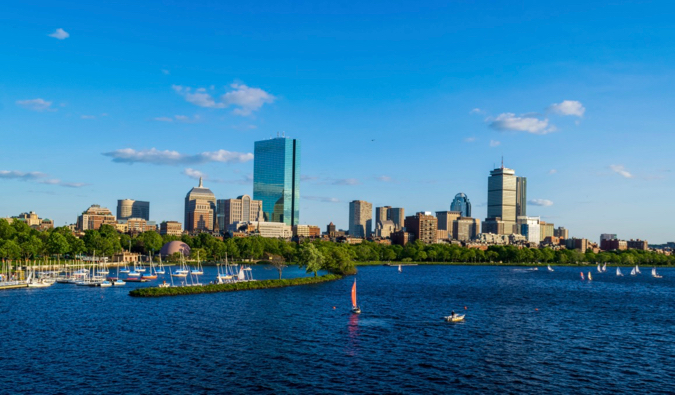 Posted: 1/18/2020 | January 18th, 2020
With its historic colonial buildings, die-hard sports fans, and lively nightlife,
Posted: 1/18/2020 | January 18th, 2020
With its historic colonial buildings, die-hard sports fans, and lively nightlife, 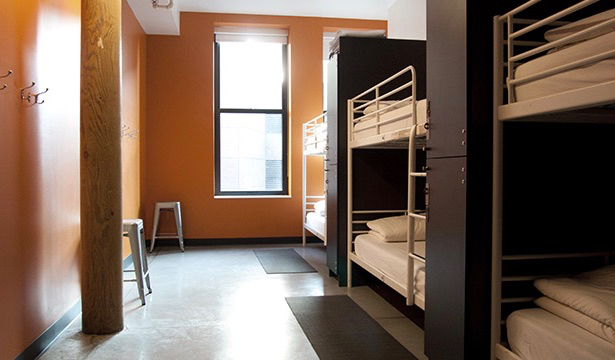


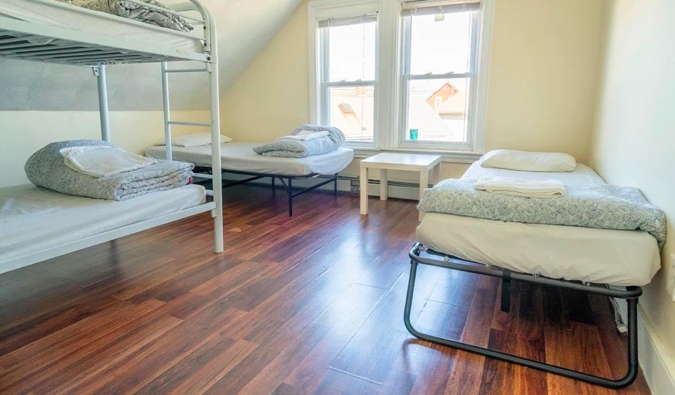 Located in an old house a few miles outside of the city center (but close to the JFK Library),
Located in an old house a few miles outside of the city center (but close to the JFK Library), 
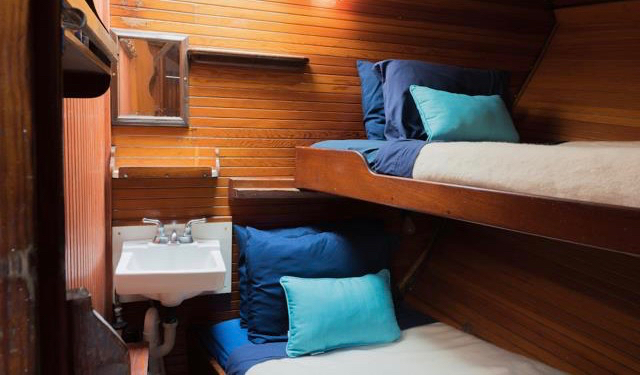 Available from June through September, this is easily the coolest place to stay in town: a functional sailing vessel,
Available from June through September, this is easily the coolest place to stay in town: a functional sailing vessel, 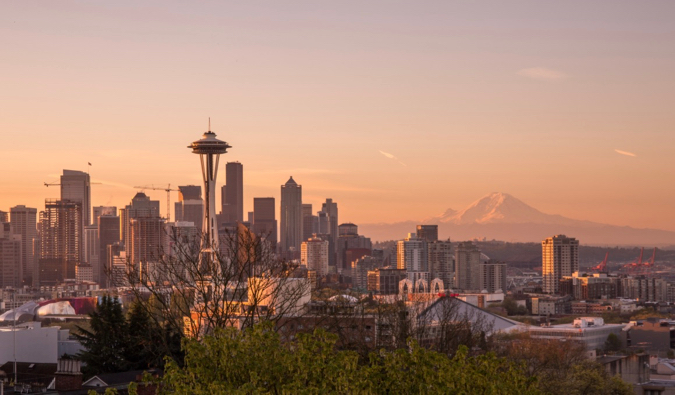 Posted: 1/18/2020 | January 18th, 2020
Tucked away in the Pacific Northwest,
Posted: 1/18/2020 | January 18th, 2020
Tucked away in the Pacific Northwest, 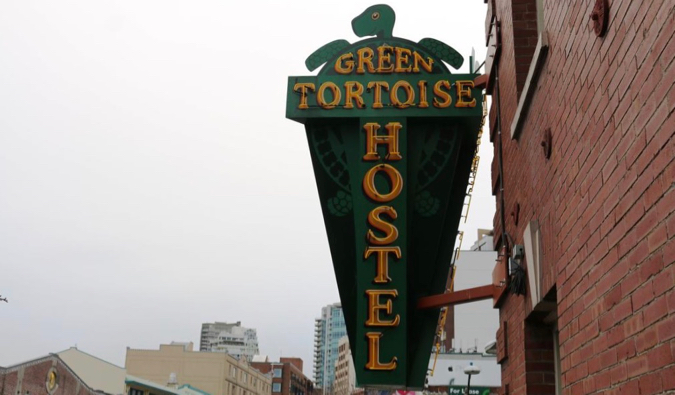 This is my favorite hostel in Seattle. The dorm beds have privacy curtains, and there are enough outlets to charge everything you might bring. The rooms aren’t very large though, and the luggage storage is under the bottom bunk, so if you’re sleeping there and your bunkmate needs something, you’ll definitely hear it. You’ll also hear music and people late at night, given its central location, so bring earplugs.
That said, the bathrooms here really set this hostel apart from others: they have rainfall showerheads and heated tile floors. The hostel also provides free breakfast, complete with eggs, cereal, fruit, and bread. There is a communal kitchen and common room with foosball and other games. They also run free walking tours and pub crawls and even host weekly ice cream socials!
This is my favorite hostel in Seattle. The dorm beds have privacy curtains, and there are enough outlets to charge everything you might bring. The rooms aren’t very large though, and the luggage storage is under the bottom bunk, so if you’re sleeping there and your bunkmate needs something, you’ll definitely hear it. You’ll also hear music and people late at night, given its central location, so bring earplugs.
That said, the bathrooms here really set this hostel apart from others: they have rainfall showerheads and heated tile floors. The hostel also provides free breakfast, complete with eggs, cereal, fruit, and bread. There is a communal kitchen and common room with foosball and other games. They also run free walking tours and pub crawls and even host weekly ice cream socials!
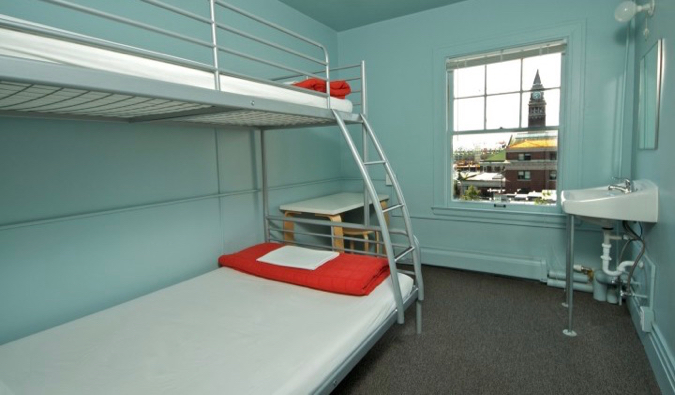
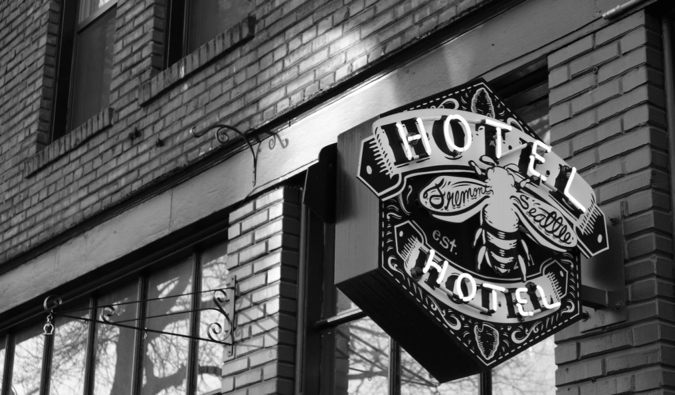
 If you like art, you’ll love
If you like art, you’ll love 